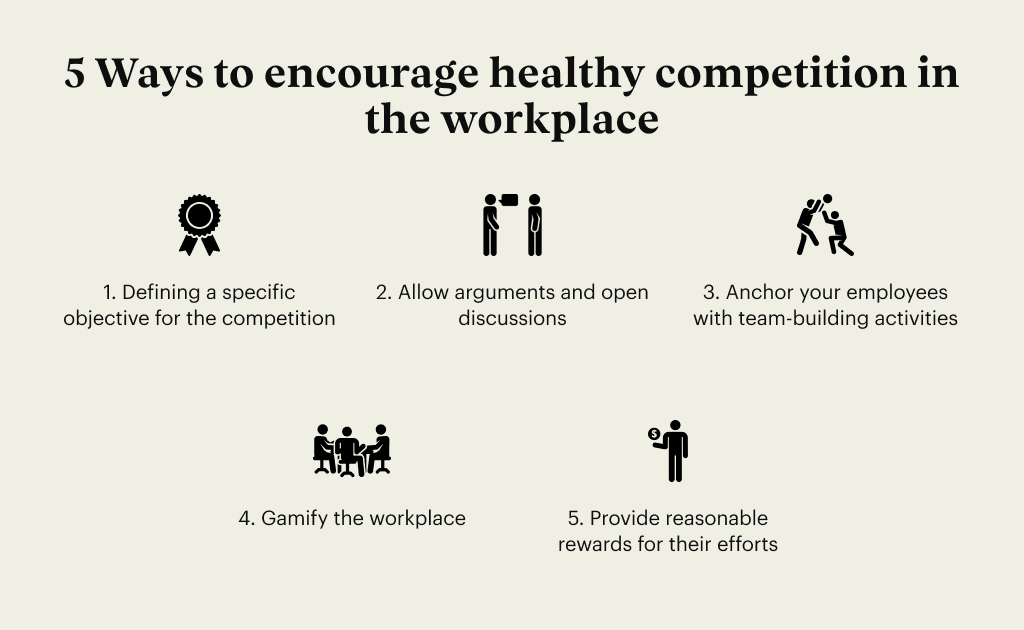Qvalon Blog article content
Written By: Jul Domingo
Contrary to popular belief, competition doesn't necessarily trigger tension or ill-will between rivals.
Think of healthy workplace competition as a catalyst to increase engagement, communication, and performance.
The right environment promotes camaraderie, creativity, and productivity, contributing both to the success of the business and to the happiness of its employees.
However, it remains true that too much competition is unhealthy for everyone involved.
In fact, 43% of employees won't hesitate to leave the company if they always feel like they need to up their game at every turn.
This only proves that there’s a fine line between a great and an unsettling work environment when it comes to competition. So ask yourself these questions:
- If you assess your workforce’s culture-o-meter, what’s your reading?
- Does your workplace motivate or burn out your employees?
Discover what constitutes healthy competition in the workplace, including what to do to foster it.
Things to consider when promoting healthy workplace competition
In any organization, collaboration is essential while competition is inevitable.
Think back to the time you were part of a team. Wasn’t it common to want to excel as a group, but there would always be competitive individuals who would want to take the lead?
The same is true for your staff. It’s human nature to want to be the best amongst their peers, even if everyone is working toward the same goal.
The good news is that these two extremes are not mutually exclusive. You can actually cultivate one while taking advantage of the other. Collaboration brings holistic results for the company while competition offers improvement, motivation, and innovation for co-workers.
On the other hand, poor teamwork decreases employee morale, according to 33% of HR officers. Lack of initiative, rewards, and appreciation can cause this shortcoming. And the key to resolving this issue and other related problems is to foster healthy workplace competition—one that encourages your staff to bring their A-game, minus the anxiety.
“Healthy means you're striving to be better every day, alongside your "competitors".
- Monica Towner (De Los Santos), Career Coach
The following conditions are essential for creating a competitive atmosphere that produces results:
Win-win mindset with a shared vision
Destructive competitive employees are those whose visions don't align with the organization. Pushing employees to win and meet their personal goals is a good start, but it’s not always enough for some people.
As humans, we have inherent competitive instincts—and it won’t do well to shush them down. You need to provide a higher form of encouragement by having your staff share a common vision
Insignificance of defeat
You can empower your teams without demoralizing and discouraging the other. Healthy competition in the workplace focuses on employees’ strengths and excellence.
It’s not that you shouldn’t give credit to top performers. You should, and it’s very much encouraged. But you have to do it in a way that uplifts everyone and motivates them to strive for a higher performance standard.
Encourage radical improvements to maintain employees’ focus on upskilling. This will redirect their goal of defeating co-employees to win and encourage them to continually strive to be better versions of themselves.
Healthy competition is when one's success doesn't come at another's expense. Therefore, you should never, ever brand anyone losers or winners at the workplace.
Transparency
Transparency in the workplace is crucial, especially when it comes to goal-driven setup. It’s up to you to communicate the organization's goals, values, principles, and expectations.
You shouldn’t keep your staff guessing what you consider to be great work. In any other case, they will be forced to compete to come out as one of the best performers.
Everyone benefits from clear communication. Give your staff immediate access to you in the form of video calls or chat, so they can ask for your help when necessary, t will develop stronger ties, motivate employees, and bring a sense of belongingness - all of which will positively affect your company’s bottom line.
Access to performance reviews
Informing employees shouldn’t stop after the onboarding process. You need to provide them with up-to-date information all the time, especially when it comes to their performance.
Consistent access to information promotes trust, comfort, involvement. And again, this circles us back to transparency, crucial for creating a family-like environment in any company.
Transparent and accessible data inspires healthy workplace competition. Employees want to understand why and how things are run in a certain way. A platform that lets employees see what they need to do as well as its impact on the company will make it easier for them to manage themselves and act accordingly.
Modern constructive feedback
69% of employees would work harder if they were better appreciated. A workplace grounded in a constructive feedback culture will reduce conflict. It will also foster friendly competition among team members.
Managers sustaining a positive atmosphere will nurture employees' growth mindset. Leaving notes to acknowledge successful efforts or instructing employees on how to improve their work can help employees focus on their jobs, rather than look at what their peers are up to.
Employee engagement
There’s always a risk in fostering healthy competition in the workplace. If you’re not careful, it could backfire. But to be fair, no investment is a pure reward, there's always a risk. When you develop a workplace competition, make sure to maximize your employees' engagement.
According to Willis Towers Watson, employee engagement refers to their enthusiasm and capacity to contribute to company success. And here are the reasons why you should prioritize engagement when fostering competition:
-
Organizations with a high employee engagement are 22% more profitable. But only 33% of employees feel engaged at work.
-
Companies with engaged employees reported a 41% reduction in absenteeism.
-
Low employee engagement is a huge wasted manpower cost.
-
Overall, low employee engagement can cost $450-500 billion annually.
5 Ways to encourage healthy competition in the workplace
According to Harvard Business Review, it’s important to portray success as a shared experience.
It’s your job as a team leader or a business owner to ensure your staff stays motivated and adequately challenged.
There are several ways you can help them see their colleagues as resources and supporters to help them reach their goals. Here are some of them:

1. Defining a specific objective for the competition
Starting a competition out of nowhere will not result in the outcome you desire. In fact, it will only add negativity to the experience, creating unnecessary rivalries along the way.
To promote positive competition, you need to outline the competition's goals and importance and discuss how it benefits the employees and the organization. Be specific with the vision so you won't have to find them scattered and wandering along the way.
And this doesn’t have to be very formal. You can conduct fun games, such as charades, during company-wide meetings and create groups for the sake of team-building. This reduces animosity amongst coworkers and creates friendships between them, which is a total win even if they lose the game.
2. Allow arguments and open discussions
Around 80% of employees would rather work alone rather than spend time in hostile work environments. Encouraging your employees to voice out their opinions will overcome this problem and promote a healthy conflict. Open discussions are the easiest way to prevent and solve conflicts and diversity. According to Gallup's study, when employees feel their opinions count, there’s a:
- 27% decrease in turnover rate
- 40% decrease in safety incidents
- 12% increase in productivity
It's better to deal with disagreements straight away rather than trying to escape them. Hold an open discussion once a month to ensure a safe work environment for your employees. This can help reduce anxieties about a competitive workplace.
3. Anchor your employees with team-building activities
In a Harvard study in 2006, heart surgeons performed better when working with a team they were familiar with. That's why you shouldn’t underestimate the value of team-building activities. Familiarity and communication between team members improve up to more than 50% when socializing.
Team building is a classic way to encourage a healthy workplace competition. It helps break barriers and enhance social relations among employees.
Some ideas for team-building activities include:
- Scavenger hunt (of course, this has to be on top of the list!)
- Office trivia
- Circle of appreciation
- Escape room (Meeting room edition)
- Pictionary
- Board games (affordable, fun, and simple)
4. Gamify the workplace
Casually conducting short-term contests is a feasible way to keep the momentum of healthy workplace competition going. The truth is, the employees' engagement decreases with longer challenges. But making the duration shorter will increase commitment and enthusiasm.
If you constantly have your staff in training, why not take it as an opportunity to make it more fun… while igniting healthy workplace competition?
You can come up with an array of work-related problems and hold business simulations for fun. It’s so simple you can even do it in the middle of a workday—and it still counts as additional training, right? Here’s to filling two needs with one deed.
Here’s a more concrete example: If you work in retail, you can create teams and turn it into a whole role-playing game. Have half of the members come in as a customer with a handful of complaints and the rest of the team can play different sales team roles, such as salesperson, supervisors, manager, etc.
Another way is to add gamification to learning management systems. There are plenty of tools you can find for it. But the activities shouldn’t always be work-related. Why not create fitness clubs and challenge the members to do certain activities? Winners can get simple rewards, not to mention an added boost to their physical health.
5. Provide reasonable rewards for their efforts
Don't forget incentives and rewards such as bonuses and promotions. When rewarded with a simple expression of gratitude by someone in authority, people become 50% more productive. How much more when you reward them incentives?
However, don’t focus mostly on sales numbers, outputs, and all that. While it pays to reward individuals that generate big bucks for your business, it can be discouraging for individuals who are also performing well… in other aspects.
If you want healthy workplace competition, you should also recognize those people whose behaviors echo what your company stands for or show outstanding values. For example, if you market your company as a sustainable brand, and you have a staff member who encourages an environmentally conscious workplace whenever possible, there’s no doubt this individual also deserves some plus points for practicing what you preach.
Exercise accurate performance metrics
As it seems, transparency is key to healthy competition in the workplace. Regardless of the industry, measuring performance and productivity is crucial. You don’t want to cause conflict and division among teammates in the first place.
And you should also compensate for the efforts of those who stood out. Using measurements the right way can maintain healthy competition in the workplace.
QVALON can help you measure staff performance, as well as creating a collaborative environment for them to enjoy a strong corporate culture.



